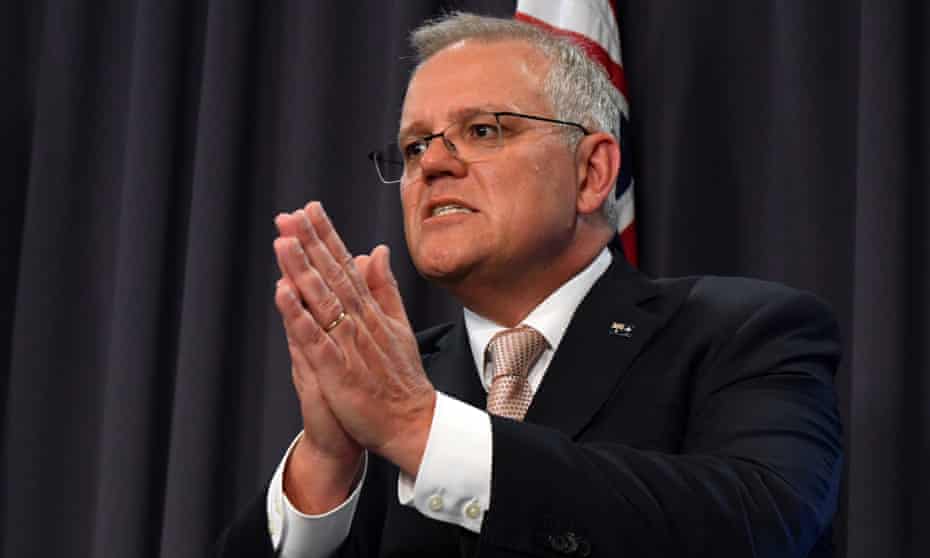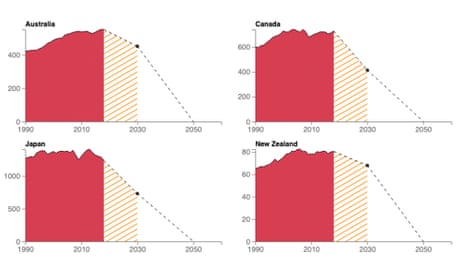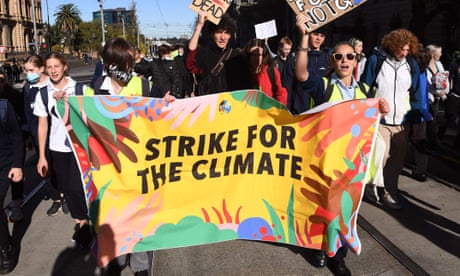Extract from The Guardian
Prime minister Scott Morrison says ‘technology breakthroughs’ will help country meet reductions targets but Labor calls plan a ‘scam’ based on a ‘vibe’

First published on Tue 26 Oct 2021 15.15 AEDT
The Australian prime minister, Scott Morrison, has released the government’s plan to reach net zero emissions by 2050 and updated Australia’s 2030 projection to between 30% and 35% as he prepares to fly to Glasgow for a United Nations climate summit.
But after facing internal resistance from members of the National party – who are in Coalition with the conservative Liberal party - the federal government won’t revise its formal 2030 emissions target, maintaining the 26-28% pledge compared to 2005 levels agreed under the Paris accord.
Morrison hailed Tuesday’s plan as a “practical way” to neutralise Australia’s emissions by 2050 but the plan showed almost a third of the abatement task is comprised of cuts via unspecified “technology breakthroughs” and “global trends” while a further 20% will be achieved through unexplained offsets.
Australia’s emissions are among the highest in the world on a per capita basis and the country has long trailed behind similar developed countries in pledging to reduce emissions.
The government has refused to release modelling underpinning the plan and is keeping details of the package – promised to secure Nationals support for the mid-century target – secret.
The plan – which Morrison promoted as “the Australian way” – is underpinned by an updated technology roadmap that prioritises investment in clean hydrogen, energy storage, low emissions steel and aluminium and carbon capture and storage. It also adds ultra-low cost solar as a new priority. The overall investment totals $20bn, the government said.
As a result, gross national income will be 1.6% higher, and Australians would be nearly $2,000 better off on average in 2050 compared to a scenario where no action was taken.
Modelling underpinning the projections would be released “eventually”, Morrison said.

The prime minister also emphasised that the “technology not taxes” plan was based on existing government programs and would not require any new legislation, despite calls from Labor and independent MPs to enshrine the target in law.
The focus of the plan was on bringing down the relative cost of low emissions technologies, which would result in an “accelerating deployment at scale across the economy”.
“Our plan works with Australians to achieve this goal. Our plan enables them, it doesn’t legislate, it doesn’t mandate, it doesn’t force them. It respects them and understands that Australians want to do this … they want to protect their industries,” the prime minister said. The policy was based on “choices not mandates”, he said.
Morrison conceded that at least 15% of the abatement task was based on “technology breakthroughs” in the future, saying this had been the experience of the modern world and no one could predict advances over the next 30 years.
“The rate of technological advance is a given, it is actually a given in the modern world,” Morrison said. “To not think that is going to play a role over the next 30 years, that would be the more surprising assumption.”
The energy and emissions reduction minister, Angus Taylor, said the 15% attributed to “established global technology trends” included technology such as low emissions cement and feed supplements that were in the “early days” of development.
“This is not technologies we don’t necessarily know about. It may well be technologies that we know quite a lot about, but have not yet gotten to the point where we can make priority technologies,” Taylor said.
“That is what has happened time immemorial. That is probably one of the safest assumptions you can make, that the rapid escalation of technology will continue to drive these costs down.”
A breakdown of the emissions reduction forecasts shows that the electricity sector will reduce its emissions by 96% by 2050, signalling the withdrawal of coal from the sector. Taylor said gas would still play a role in Australia’s electricity generation mix.
The transport sector would achieve a 79% cut in emissions supported by battery charging and hydrogen refuelling stations as “enabling” infrastructure. Emissions from mining, industry and manufacturing would drop 54%, while in agriculture, the forecast is for a 40% cut.
Labor blasted the proposal as a “scam” that lacked substance and criticised the government for its decision not to release details of the deal struck with the Nationals.
The opposition leader, Anthony Albanese, said Morrison had outlined the “vibe” of a climate policy which had no new commitments.
“We haven’t seen the modelling, and we haven’t had the detail. Because there is net zero modelling, net zero legislation and net zero unity,” Albanese said.
“But in their own words, there is nothing new in this plan. The word plan doesn’t constitute a plan no matter how often he said and what form it’s printed. As always, with this prime minister, it is all about marketing. All about the spend, never about the substance.”

“They’ve introduced an emissions trading promotions policy. That’s all we’ve got.”
Morrison said the agreement with the Nationals had resulted in the inclusion of a five-yearly review of the net zero target that would be undertaken by the Productivity Commission and a pledge to invest in the regions and to cut red tape.
He said any other spending commitments made as part of the deal would be unveiled in the lead-up to the next election.
“All of our policies will be announced before the election, in particular, there will be a budget next year,” Morrison said.
After abandoning efforts to update Australia’s 2030 emissions target from the 26% to 28% cut on 2005 levels, Morrison announced that the country was on track to achieve an actual reduction of between 30% and 35% on 2005 levels.
This was attributed to the rapid take-up of rooftop solar, energy efficiency measures, and changes in land use.
In question time on Tuesday, Morrison presented the government’s policy as one that was “based on choices, not mandates on the Australian people”.
The deputy prime minister and Nationals leader, Barnaby Joyce, went further, saying Labor’s policy was only about legislation.
“Legislation brings in laws, and laws outlaw things, and laws enforce penalties, so we do have a clear differentiation, we have a chasm between the two different policies because we believe in inspiration and technology and they believe in laws and penalties.”
Albanese is yet to detail Labor’s climate policy after it abandoned a previous target of a 45% reduction by 2030 after the last election.
Labor is expected to unveil its new “ambitious” policy after the Glasgow summit, with Bowen saying it would be announced in “the coming weeks”.
No comments:
Post a Comment